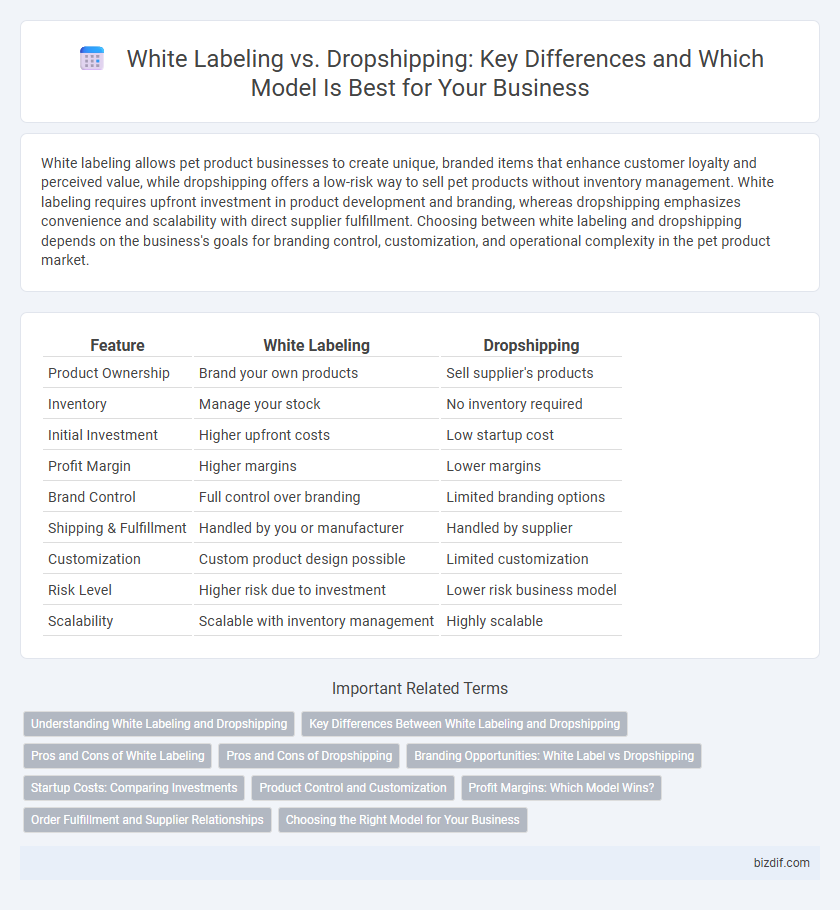White labeling allows pet product businesses to create unique, branded items that enhance customer loyalty and perceived value, while dropshipping offers a low-risk way to sell pet products without inventory management. White labeling requires upfront investment in product development and branding, whereas dropshipping emphasizes convenience and scalability with direct supplier fulfillment. Choosing between white labeling and dropshipping depends on the business's goals for branding control, customization, and operational complexity in the pet product market.
Table of Comparison
| Feature | White Labeling | Dropshipping |
|---|---|---|
| Product Ownership | Brand your own products | Sell supplier's products |
| Inventory | Manage your stock | No inventory required |
| Initial Investment | Higher upfront costs | Low startup cost |
| Profit Margin | Higher margins | Lower margins |
| Brand Control | Full control over branding | Limited branding options |
| Shipping & Fulfillment | Handled by you or manufacturer | Handled by supplier |
| Customization | Custom product design possible | Limited customization |
| Risk Level | Higher risk due to investment | Lower risk business model |
| Scalability | Scalable with inventory management | Highly scalable |
Understanding White Labeling and Dropshipping
White labeling involves creating products manufactured by a third party but branded with your own company's logo, allowing businesses to build a unique identity without handling production. Dropshipping lets retailers sell products directly from suppliers to customers without holding inventory, streamlining logistics but limiting branding control. Understanding these models helps entrepreneurs choose between building a custom brand and minimizing upfront costs with supplier-managed fulfillment.
Key Differences Between White Labeling and Dropshipping
White labeling involves customizing generic products with your own brand and packaging, allowing for greater control over branding and customer experience, while dropshipping sells products directly from suppliers without branding adjustments. Inventory management in white labeling requires upfront investment to stock products, contrasting with dropshipping's order fulfillment model where suppliers handle storage and shipping. Profit margins tend to be higher in white labeling due to brand exclusivity, whereas dropshipping offers lower risk and less overhead but with slimmer margins.
Pros and Cons of White Labeling
White labeling offers brand control and higher profit margins by allowing businesses to customize products and packaging, enhancing customer loyalty and perception. However, it requires larger upfront investment, inventory management, and longer lead times compared to dropshipping, which offers lower risk and flexibility but less control over product quality. Choosing white labeling suits companies aiming for strong brand identity and scalability, while dropshipping is preferred for testing markets and minimizing operational complexity.
Pros and Cons of Dropshipping
Dropshipping offers low startup costs and eliminates the need for inventory management, making it accessible for entrepreneurs seeking minimal upfront investment. However, it faces challenges such as lower profit margins and limited control over product quality and shipping times, which can impact customer satisfaction. Success in dropshipping depends on selecting reliable suppliers and effective marketing strategies to overcome operational constraints.
Branding Opportunities: White Label vs Dropshipping
White labeling offers extensive branding opportunities by allowing businesses to customize products with their own logos and packaging, creating a unique brand identity that fosters customer loyalty. Dropshipping typically involves selling third-party products with limited control over branding elements, making it harder to differentiate in competitive markets. Investing in white label solutions enhances brand recognition and long-term customer engagement compared to the more generic approach of dropshipping.
Startup Costs: Comparing Investments
White labeling requires higher startup costs due to product development, branding, and inventory expenses, often reaching several thousand dollars. Dropshipping minimizes initial investments by eliminating inventory purchases, with expenses primarily limited to website setup and marketing. Entrepreneurs seeking lower financial risk typically prefer dropshipping, while those willing to invest in unique branding may choose white labeling.
Product Control and Customization
White labeling offers greater product control and customization by allowing sellers to brand and modify products according to specific market needs, enhancing brand identity and customer loyalty. Dropshipping, while minimizing inventory risks and upfront costs, limits control over product quality and customization, as sellers rely on third-party suppliers for fulfillment. Choosing between white labeling and dropshipping hinges on the desired level of product differentiation and brand development in the e-commerce strategy.
Profit Margins: Which Model Wins?
White labeling often yields higher profit margins by allowing sellers to create unique products with branded packaging, reducing direct competition and enabling premium pricing. Dropshipping offers lower upfront costs but typically results in slimmer margins due to reliance on third-party suppliers and increased price competition. For entrepreneurs prioritizing profitability, white labeling provides greater control over pricing strategies and brand value, leading to potentially stronger financial returns.
Order Fulfillment and Supplier Relationships
White labeling involves a supplier manufacturing products that are rebranded and sold under a retailer's brand, giving the retailer greater control over order fulfillment and consistent quality standards. Dropshipping relies on the supplier to handle inventory storage, packaging, and shipping directly to customers, which reduces upfront costs but limits control over fulfillment speed and accuracy. Strong supplier relationships are crucial in both models, but white labeling demands more collaboration on product customization and branding, while dropshipping focuses on reliable logistics and inventory coordination.
Choosing the Right Model for Your Business
White labeling offers control over branding and product quality, allowing businesses to create a unique identity, while dropshipping minimizes upfront investment and inventory risks by fulfilling orders directly from suppliers. Selecting the right model depends on factors such as budget, desired level of customization, supply chain control, and long-term scalability goals. Entrepreneurs seeking brand differentiation and higher profit margins may prefer white labeling, whereas those prioritizing low startup costs and simplified logistics often choose dropshipping.
White Labeling vs Dropshipping Infographic

 bizdif.com
bizdif.com